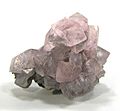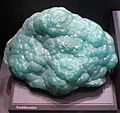Smithsonite facts for kids
Smithsonite is a special kind of mineral. It is made mostly of zinc carbonate, which is a chemical compound with the formula ZnCO3. This mineral is very important because it is a main source, or ore, from which we get zinc metal.
Smithsonite has a hardness of 4.5 on the Mohs scale. This scale helps scientists measure how hard a mineral is. It also has a specific gravity of 4.5, which tells us how dense it is compared to water. Sometimes, a little bit of the zinc in smithsonite can be replaced by manganese, creating a similar mineral called manganese carbonate.
Contents
What Smithsonite Looks Like
Smithsonite can be found in many beautiful colors. It can be blue, green, pink, yellow, or even colorless. The color often depends on what other tiny elements are mixed in with the zinc carbonate. For example, a small amount of copper can make it look green or blue.
Different Forms of Smithsonite
This mineral often forms in interesting shapes. It can look like bubbly masses, smooth layers, or even tiny, sparkling crystals. These different forms make smithsonite a favorite among mineral collectors.
Where Smithsonite is Found
Smithsonite is usually found in places where other zinc ores have been changed by water and air over a long time. It often forms in the upper parts of zinc deposits. Some famous places where smithsonite is found include Mexico, Namibia, Australia, and the United States.
Uses of Smithsonite
The main use for smithsonite is to get zinc metal. Zinc is a very useful metal. It is used to protect other metals from rust, like on steel fences or car parts. Zinc is also used in batteries and to make brass, which is an alloy of copper and zinc.
Images for kids
See also
 In Spanish: Smithsonita para niños
In Spanish: Smithsonita para niños








